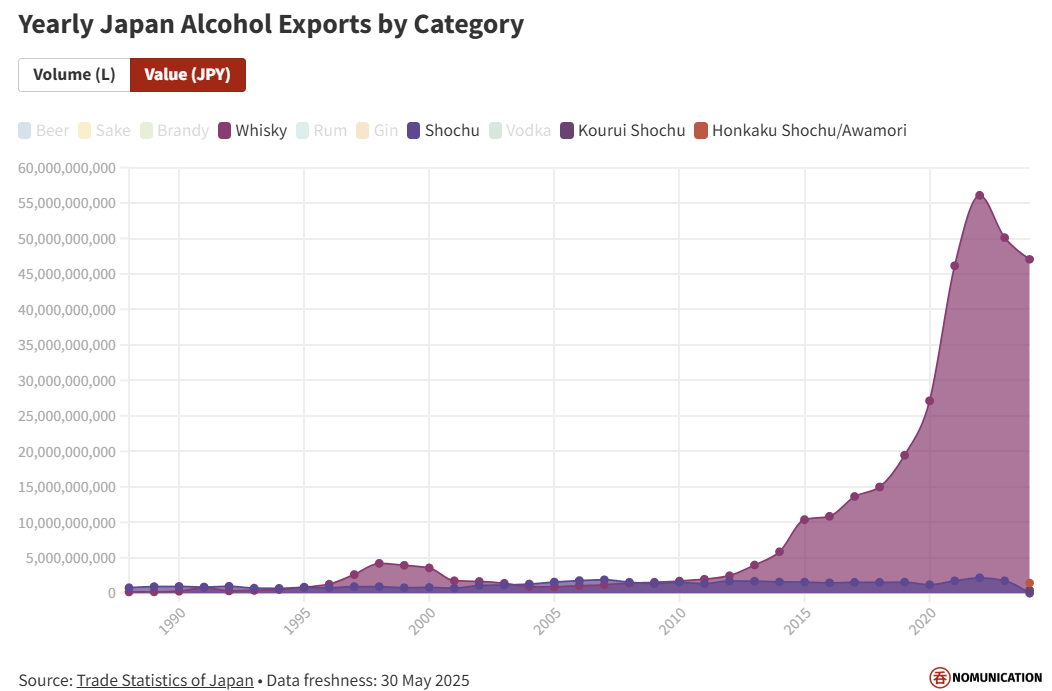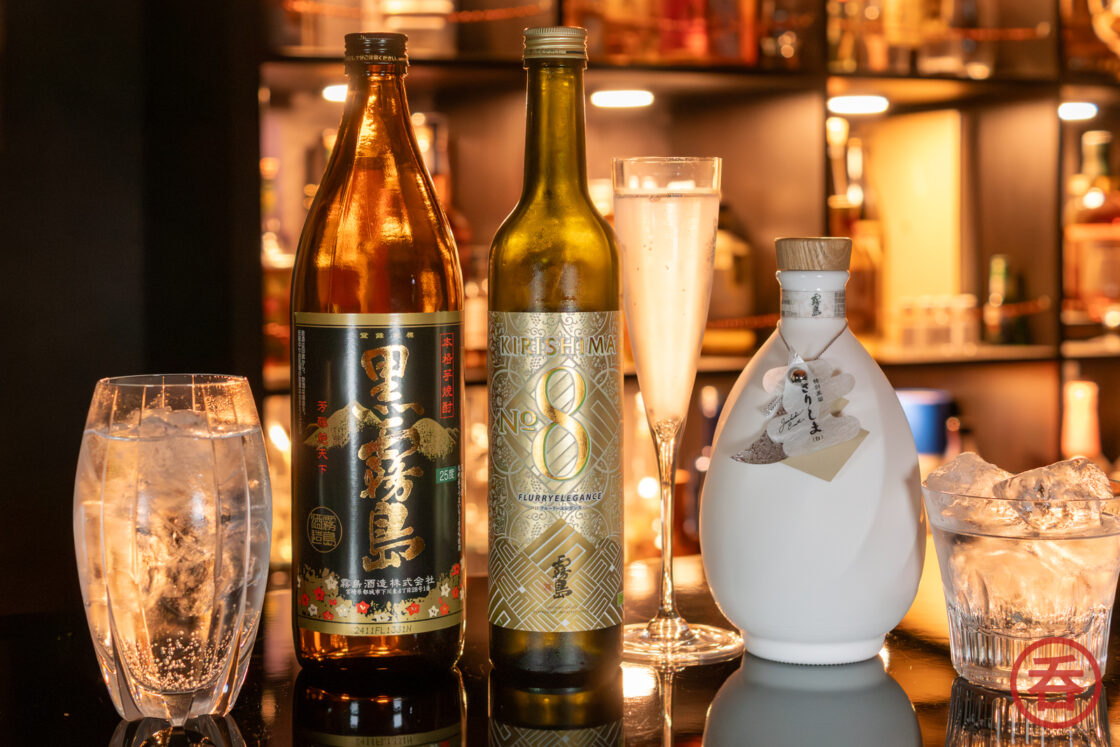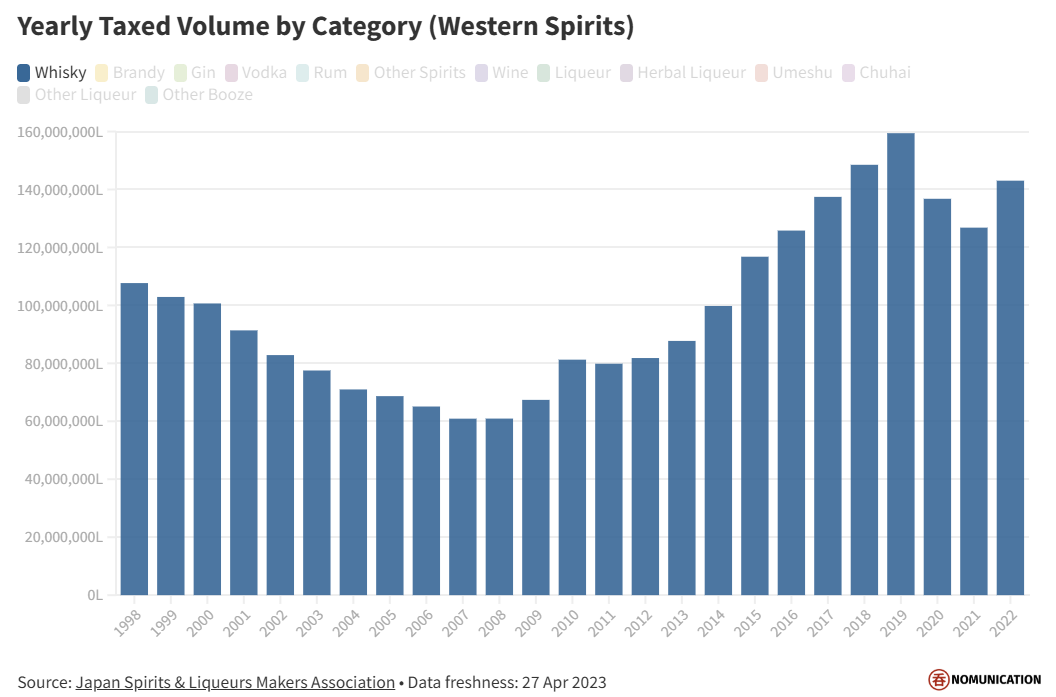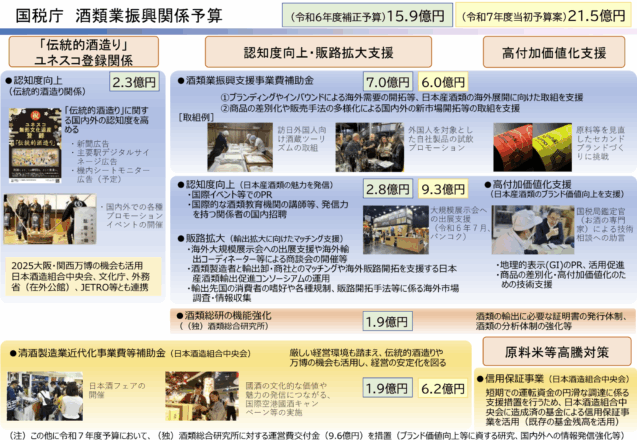We talk a lot on this site about relatively obscure bottles of honkaku shochu/awamori and some of the more technical aspects of the category. But today we’re spending some time with bottles from the granddaddy of honkaku shochu: Kirishima Shuzo.
When I say that Kirishima Shuzo is the granddaddy of shochu, I’m referring to a few different things here. Kirishima Shuzo is Japan’s largest maker of shochu by sales. The latest numbers from Teikoku Data Bank, from 2023, show Kirishima with sales of 59.4 billion yen. The next largest shochu maker is Sanwa Shurui (of iichiko fame), with sales of 26 billion yen. Kirishima Shuzo has held the #1 spot for 12 years running now, and the gap between them and the competition is quite astounding: they’re larger than the combined sales of 38 of the top 50 shochu makers in Japan.
Kirishima Shuzo traces its history back to 1916 in Miyakonojo, Miyazaki. They released their first shochu that year, made with locally grown sweet potatoes and black koji. Fast forward over a century, and the company’s flagship shochu—also the world’s most ubiquitous shochu—is Kuro Kirishima (“kuro” is Japanese for black), still using local sweet potatoes and black koji.
About honkaku shochu
As you’re aware, shochu is a vast category with a wide variety, generally broken down into two subcategories: kourui shochu and honkaku shochu/awamori. The former is more akin to a vodka in that it’s continuously distilled and deliberately lacking flavor and aroma. The latter has a history dating back to the 16th century, is pot-stilled, and is typically distilled once, although it doesn’t have to be, and aims to express the underlying flavors, aromas, and textures inherent in the ingredients.
We use the Japanese word “honkaku” fairly liberally around these parts because the industry appears to have settled on using it as-is (Satsuma Shuzo, Hamada Syuzou, JSS, and JETRO all refer to it by this name). That’s fine by me. The word can mean proper, serious, or genuine, depending on the context. In shochu, you may sometimes hear it referred to as “authentic” shochu, but I’m not particularly fond of that translation. It borders on gatekeeping by implying kourui/other shochu is inauthentic. People ordering lemon sours or Hoppy at an izakaya across the country know they’re drinking shochu. If that’s not authentic, I don’t know what is.
I bring this up because Kirishima Shuzo’s 2nd generation president, Junkichi Enatsu, had the bright idea to use the word “honkaku” when referring to this category of shochu.
Coining the phrase “honkaku shochu”
In 1953, Japan’s liquor tax code was revised to split shochu into two subcategories: kourui (甲類), that vodka-ish type, and otsurui (乙類), the pot-stilled type. In this context, you can roughly translate these categories as “Grade A (甲)” and “Grade B (乙).” The Japanese phrase 甲乙付けがたい means “it’s a toss-up,” as in you can’t determine which of the two is better. That may have been the government’s intention with the use of 甲 and 乙, but if you and everyone who works for you is busting their asses everyday to make good shochu, the “Grade B” wording probably won’t sit well.
The Japanese public also took notice. While we don’t have any numbers, the sales of “Grade B” shochu took a hit because they got it in their heads that single-distilled traditional shochu was, well, grade B. Enatsu-san’s solution, presented in 1959 to the Kyushu meeting of traditional-style shochu makers, was to put a positive spin on it and label their products as “honkaku shochu.”
In 1958, Kirishima Shuzo began using the term “honkaku” in their marketing materials, and they made a point to use it when discussing their products. In April 1962, the government officially recognized the phrase “Honkaku Shochu,” and this is how we still refer to this type of shochu today.
Speaking of today
If we examine the combined sales of the top 50 shochu makers, honkaku and otherwise, they totaled 309 billion yen in 2008. In 2022, the same number was 222.7 billion yen, representing a 27.9% decrease. Meanwhile, Japan’s domestic shipments of whisky increased from 60.9M liters to 143M liters over the same period, or an increase of 134% (guess why).
That’s to say, domestically, shochu is facing stiff competition from other spirits such as whisky and gin these days.
What’s the situation outside the country? We all know the success story of Japanese whisky overseas, but where is shochu?

Right, so while the JPY export value of whisky has increased from 1.42B JPY in 2008 to 56B JPY in 2022, shochu exports have risen from 1.56B JPY to 2.17B JPY. And yes, shochu exports were worth more than whisky exports in 2008… those were different times!
These numbers suggest that shochu may have, quite literally, missed the boat of overseas Japanese drinks success. I largely agree with shochu expert Chris Pellegrini’s take in his recent interview in The Spirits Business, where he says that the wider industry and government need to do more to promote the category as a whole. Sake has seen widespread adoption worldwide as the “official drink of Japan” because it offers extensive food-pairing opportunities, similar to those found in wine. And there’s plenty of government backing to make that happen.
While shochu has earned its place on the izakaya table, I suspect there is minimal opportunity to take space away from beer, wine, and sake at the dinner table. Shochu needs to find its way to the bar counter instead. The complexity of shochu demands brand-agnostic education programs and marketing support.
Kirishima Shuzo overseas
Kirishima Shuzo’s honkaku shochu is available, well, everywhere in Japan. They have been exporting since the 1990s and are currently in around 25 markets globally. From 2018 to 2020, it was served at the Oscars Governors Ball, the official Academy Awards afterparty.
Here’s none other than Wolfgang Puck talking about Kirishima Shuzo’s honkaku shochu. He apparently likes it cold.
High-profile events like this can help shochu, and to their credit, I’m guessing the Miyazaki government was involved, as Miyazaki beef was served at the same event.
Kirishima Shuzo established an international business development department in 2019. In 2024, they introduced their first product developed from the ground up for overseas markets: Kirishima Melt Barley. While originally export-only, it’s now available here in Japan directly from the distillery (and only directly).
Melt Barley is an extension of the “Kirishima Melt” series introduced for the domestic market in 2024. That series is basically what happens when you take their standard lineup of sweet potato-based shochus and age them in oak casks. Due to the coloration the spirit gets from the wood, you can no longer legally call it shochu.
Kirishima Melt Barley, as the name indicates, uses barley rather than sweet potato. It’s been aged for a total of 21 years, maturing in both steel tanks and sherry casks (and no, I don’t know how long the latter was).
This is kind of a head-scratcher. Here you have Japan’s largest shochu maker whose entire philosophy behind modern Kuro Kirishima is “the four 100%s.” 100% Kyushu-grown sweet potato, 100% Kirishima water, 100% Japanese rice, and 100% produced at their own distillery. I mean, they literally invented the phrase “honkaku shochu.”
And, yet, their first overseas-oriented product is a) not a honkaku shochu, b) doesn’t use sweet potatoes, and c) at least partially relies on cask aging to build a flavor profile rather than celebrating the joys of local sweet potatoes, rice koji, yeast, and water. According to the news release, their research of overseas markets indicated that familiarity with whisky and brandy would make luxury cask-aged barley shochu more approachable. I don’t disagree with that assessment, but how does something like Kirishima Melt Barley move the needle for honkaku shochu outside Japan? I’ve not had it, but if a barley shochu is spending even just a couple years in sherry casks, my guess is it comes out tasting way, way more like a whisky than a honkaku shochu.
My hunch is that there’s a simple answer: Kuro Kirishima is already available everywhere inside and in plenty of places outside Japan, so they surely can’t call it the first overseas-oriented product. Kirishima Melt Barley is likely to supplement, rather than replace, Kuro Kirishima.
Kirishima Shuzo in Japan
Kirishima Shuzo’s domestic core lineup spreads across six bottles:
- Kuro Kirishima, Japan’s (and the world’s) go-to honkaku shochu, made with black koji and satsuma sweet potato. Colloquially known as “Kurokiri” in Japan
- Shiro Kirishima, using white koji and yeast developed by the Miyazaki Prefecture Food R&D Center
- Aka Kirishima, made with Murasaki Masari purple sweet potatoes (the anthocyanin in these potatoes reacts with the citric acid produced by koji, yielding a red moromi, thus the name “aka,” or red)
- Akane Kirishima, made with orange-colored Tama Akane sweet potatoes, fruity with peach and orange
- Kuro Kirishima EX, a version of Kuro Kirishima intended to balance sweetness, umami, and mellowness with the “thick” and “crisp” notes of standard Kurokiri
- Torafu Kirishima, bringing together yellow koji used in sake with black koji used in Kuro Kirishima
There are plenty of other bottles in the full lineup that focus on different aspects, such as using sweet potato-grown koji (rather than rice-grown koji), barley honkaku shochu, and cask aging. Let’s try a few!
Tasting: Kuro Kirishima, KIRISHIMA NO. 8, Tokubetsu Joryu Kirishima (White)
Kuro Kirishima, a.k.a. “Kurokiri”
If you’re a reader of this site and you haven’t had Kuro Kirishima, that’s something you should have done yesterday.
The bottle first hit the local Miyazaki market in June 1998, and the national market in May 1999. Just to give you an idea of the scale of production here, Kirishima Shuzo says they:
- Go through 400 tons of sweet potatoes per day, or around 100,000 tons per year, requiring the equivalent of 3,600 hectares to grow (about 10x the land area of Central Park in New York)
- Have 1.32 quintillion yeast cells working at any given time
- Produce 200,000 1.8L bottles of shochu per day
- Can make 6,300 1.8L cartons of shochu per hour on one production line
- Once shipped 1.545 million bottles of shochu in a single day from their factory and distribution centers
These numbers are staggering. That’s a liter of shochu per year for every person in Japan, given the country’s population of 124.5 million people.
In LPA (liters of pure alcohol) terms, assuming 25% abv, that’s 32.85 million LPA per year, or over 20% of Japan’s entire output of shochu (159.7 million LPA per NTA’s FY2024 numbers).
I’m not sure if Enatsu-san had these numbers in mind when he coined the term “honkaku shochu.” Kirishima Shuzo is clearly honkaku about making hundreds of truckloads of the stuff every day. On to the bottle.
Nose: Rich & deep sweet potato with slight sweetness of cherries, green apple, and honeysuckle
Palate: The texture is the main draw here: thick and oily. The sweet potato doesn’t shine through, making this approachable even for someone who has never had a sweet potato shochu.
Finish: Short and dry, trailing sharp bitterness
Score: B+
Retail Price: 999 yen (pre-tax) / 900ml / 25% abv
If there was ever a “table shochu,” this is it. It’s not especially adventurous, and literally nobody is asking for that either. At this price point, at least here in Japan, you have no excuse to not have a bottle on your shelf.
Kirisihima No.8
This bottle was released in 2023 in the Tokyo area and 2024 in the rest of the country. The story goes that Kirishima Shuzo set out to make their own variety of sweet potato and performed 37 different cross-breeding experiments. “No.8” is a reference to the 8th trial — a hybrid of the Tama Akane used in Akane Kirishima and Simon No.1 potatoes from Brazil. They note that this is the first time a shochu maker has developed their own variety of potato, used it to make shochu, and commercialized the product.
When they added their “Elegance Yeast,” also developed in-house, the result is a highly aromatic shochu with intense notes of orange and muscat. Specifically, it contains 3576.3ppb of five different monoterpene alcohols (MTBs): linalool, terpineol, citronellol, nerol, and geraniol. These all contribute to the herb and fruit-forward profile. The company states that this is approximately 14 times the MTB level of regular Kuro Kirishima (245.3ppb).
While that all sounds pretty technical, the ultimate goal here is to reach a new audience for sweet potato shochu in Japan (see the declining domestic industry sales figures above). 89% of respondents who walked out of last year’s pop-up events for Kirishima No.8 in Tokyo, Kumamoto, Osaka, and Fukuoka did so with their impression of sweet potato shochu changed. Will it change mine? Let’s find out.
Nose: Citrus-forward with orange, pear, green apple.
Palate: Interesting interplay between peach and mango alongside some potato sweetness. If you’re looking for intense potato flavor, you won’t find it here.
Finish: That potato does linger for a fleeting moment. We don’t get that bitter “bite” as we have with Kuro Kirishima.
Score: B
Retail Price: 1,340 yen (pre-tax) / 900ml / 25% abv
Here’s a honkaku shochu that occupies an interesting space. It’s honkaku shochu, sure, but bizarrely, it’s not a “potato-forward” sweet potato shochu. This begs the question: is it really a sweet potato honkaku shochu if it doesn’t taste much like sweet potato? Kirishima Shuzo’s answer appears to be heck yeah, we made our own sweet potato, and this is what it tastes like! Put my impression down as “changed” too.
Tokubetsu Joryu Kirishima (White)
The white version of “Specially Distilled” Kirishima weighs in at 40% abv, making it much stronger than the above two offerings. There’s also a red version — my assumption is that this white bottle is a higher abv/heads-heavy version of the Shiro Kirishima with white koji, while the red bottle is a higher abv/heads-heavy version of the Aka Kirishima that uses purple sweet potatoes.
In either case, what makes this distillation special? The materials I’ve found indicate that they’re only using distillate that has higher abv and aromatics — i.e. closer to the heads when a distiller makes his or her cut. There’s also apparently some blending with a matured version of the spirit to mellow things out, but I don’t have any details on that. So no, it’s not just a simple “hanatare” version of their standard releases.
And that bottle design. Wow. The company reached out to Inoue Manji, a Living National Treasure who is best known for his work with the Hakuji style of Arita pottery. The “twist” in it is dubbed “uzumon,” and you can see examples of this across his work. This is one of those bottles where you’ll want to keep the empty.
Nose: There’s a lot of the same pear and apple notes we find on the other bottles, but rather than bright and fresh, these have been left to ripen in the blazing hot sun. That’s to say it’s fruity, but noticeably more mellow.
Palate: Velvety mouthfeel despite the heat. The sweet potato is served with a potpourri of herbs and spices: fans of rye whiskies will find themselves right at home here with black pepper, cloves, and cinnamon.
Finish: The 40% abv allows for a longer finish here. Again, it doesn’t quite have the bite of the Kuro Kirishima, but for these kinds of bitter spices, we don’t necessarily need it.
Score: A
Retail Price: 3,441 yen (pre-tax) / 720ml / 40% abv
I don’t mean this in a negative way, but it’s tough to believe this bottle came out of the same factory as Kuro Kirishima. This flavor profile is highly complex and offers a lot to both newcomers to the category and die-hard sweet potato shochu fans.
Japan ByFood YouTube
I recently had the pleasure of doing an episode for the Japan ByFood YouTube channel entitled “Kirishima Shuzo.” While it leans towards the food pairing angle–that’s channel name, after all–we do go through some of the basics of shochu, how Kuro Kirishima fits with izakaya staples, and some of the basics of izakaya drinking culture. The video was just released today. Watch it below!
Hi there! I created and run nomunication.jp. I’ve lived in Tokyo since 2008, and I am a certified Shochu Kikisake-shi/Shochu Sommelier (焼酎唎酒師), Cocktail Professor (カクテル検定1級), and I hold Whisky Kentei Levels 3 and JW (ウイスキー検定3級・JW級). I also sit on the Executive Committees for the Tokyo Whisky & Spirits Competition and Japanese Whisky Day. Click here for more details about me and this site. Kampai!





Thank you for an excellent write-up.
My father-in-law is from Miyakonojo, so Kirishima Sochu holds a special place in his – and by extension our – family. We travel down to Miyakonojo once every other year or so, but have never been to the Kirishima distillery until this year, when some plans fell through, and it was suggested we visit the distillery instead. Since it was Obon, there were no guided tours as usual. Instead, the distillery was open, and we were free to explore it at our own pace. The viewing areas above the factory floor were very well done, with good information (displays had English too, if I remember correctly). There was what looked to be a generous sampling area at the end, but unfortunately, I was driving, so I couldn’t partake.
In any case, I wanted to pick up something I could only get at the distillery, so I bought a bottle of Kirishima x Snow Peak collaboration 20-year-aged shochu. The limited information I found about it suggests it was aged in oak barrels and earthenware jars (?). I suspect it’s mostly from the latter, as I would expect the color and price to be darker and more expensive, respectively, if it leaned more towards barrel-aging. Still, there’s definitely a vanilla aroma that’s typical of oak barrels present. Very smooth and tasty – I can’t think of many other 20-year-old drinks that can be bought for 4000, so it’s nice to have on the shelf.
The bakery, which uses leftovers from the distilling process (maybe the koji), also produces fantastic baked goods.
Anyway, great write-up once again. It definitely brought back memories.
Glad the article brought back memories for you! Miyazaki is definitely a beautiful and tasty part of Japan.
One thing to note about shochu is that legally there are limitations on how much color it can have, because it enjoys something of a tax benefit versus whisky. The tax office supposedly doesn’t allow it to have color so they can tell it apart from whisky, at a glance. If it has too much color, it gets taxed as a “spirit” rather than a shochu.